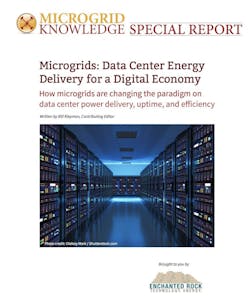This special report series focuses on data center microgrids for the colocation and big data industry. The third entry explores how microgrids are changing colocation and data center economics.
Get the full report.
Data centers are increasing in number across the US and around the globe. They are the new industrial factory of the modern digital economy and require a massive amount of power to support their high-tech operations. Data centers are located in every state, but the largest hyperscale data centers are sited where power is the least expensive. However, low-cost power does not ensure highly reliable power, so the standard data center design includes backup power systems that can carry the facility, computing and infrastructure loads without interruption during a power outage.
These backup power supplies are typically large arrays of diesel generators connected in parallel strings to create maximum resiliency when coupled with battery based uninterruptible power supplies (UPS). However, diesel generators present a handful of challenges to data center operators. For example, they have high emissions, which makes environmental permitting and reporting burdensome. Additionally, they are expensive to own because of the high upfront cost and ongoing operations and maintenance costs. They also sit idle for most of the year and do not provide grid services, which makes them an expensive drag on both the balance sheet and income statement of the data center operators.
These generators are an essential component in mitigating operational risk in the data center. Still, they lack the higher level of resiliency as well as other key benefits that a microgrid system offers.
With all of this in mind, let’s take a few minutes to break some legacy paradigms around economics and the overall cost of today’s microgrid solutions.
Overcoming common economic myths surrounding microgrids
The first challenge we often hear about is that microgrids are expensive to deploy and maintain. The reality is that it depends on a variety of factors, and with innovative business models, it can be significantly cheaper than traditional alternatives.
It is crucial to consider the total cost of an outage, in dollars, lost time, reputational damage, and so on, and then compare it to the price of a resiliency microgrid system.
Additionally, microgrid costs have been falling in recent years. This is primarily due to a decline in cost of the kind of supply assets used by many contemporary microgrids.
Another misconception is that you might need to pay for everything upfront. In some cases, this is true. However, with microgrid-as-a-service (also called energy-as-a-service) offerings, contracts require little or no upfront capital paid by microgrid customers. Instead, customers pay for their microgrid service in a budgeted manner, much as they do if they buy it from a utility, except they have the added benefit of backup power during grid outages. A third party owns the project and takes the operational and financial risk.
It is important to note that microgrids vary dramatically in size and complexity and, more importantly, purpose, which creates a wide cost variance. The cost of your design depends on where and why the microgrid is built and what kind of power generation it leverages. Photo:
Gorodenkoff/Shutterstock.com
It is important to note that microgrids vary dramatically in size and complexity and, more importantly, purpose, which creates a wide cost variance. The cost of your design depends on where and why the microgrid is built and what kind of power generation it leverages. For data centers, an advanced microgrid should cost less than an equivalent diesel back-up plant.
With microgrid-as-a-service offerings, customers pay for their microgrid service in a budgeted manner, much as they do if they buy it from a utility, except they have the added benefit of backup power during grid outages.
To further help with costs, government grants and other clean energy incentives can drive down customer costs. California, Connecticut, Maryland, Massachusetts, New Jersey, and New York are among the states that give grants for microgrids or resiliency projects.
Key microgrid economic and deployment considerations
When working with microgrid solutions, consider the following:
- Tightening reserve margins: Texas has recently seen a narrowing of its reserve—the cushion between supply and demand margins—as power plants retire. This has caused a spike in wholesale power costs when demand for electricity is high. While the problem may be unique to the state right now, it offers a warning about the risk of being grid-dependent.
- Rising utility rates: Utility rates have risen historically, so it’s reasonable to expect your costs to rise. Microgrids can offset those cost increase
- Providing assured on-site power supply in a variety of use cases: If you are in a rural or remote location, finding reliable sources of power can be a challenge. Even in urban areas, staying resilient and maintaining uptime becomes more challenging because of severe weather and aging grid infrastructure. It’s essential to understand what an outage costs for you and where a microgrid makes sense.
- Improving power efficiency: As compute density increases, you have to look at the economics of power. That means working with power most efficiently and doing your best to reduce energy waste. The UT Austin example points to a microgrid architecture that is sized to be net-zero, to produce only what it needs, therefore never wasting resources. Equally important, an advanced microgrid can manage the load for maximum efficiency. Portions of your facility may require less power at certain times. Air conditioning, for example, can be reduced in offices not in use.
- Leveraging better pricing: Microgrids give you options. You can leverage on-site power sources or you can purchase grid power, depending on which offers the best pricing as electricity costs change throughout the day.
- Improving power quality: Data centers are sensitive to fluctuations in power quality. A microgrid helps maintain steady voltage and frequency.
Catch up on the first and second entry in the report series that explores the evolving relationship between data centers and the environment.
And also stay tuned. In the coming two weeks this Microgrid Special Report series will explore the following topics:
- What’s New? The Microgrid is a Lot More Efficient — Effortless to Run
- Microgrid Partners Aim to Change Power Delivery, Efficiency and Economics
Download the full Microgrid Knowledge report, “How Microgrids are Changing the Paradigm on Data Center Power Delivery, Uptime, and Efficiency,” free of charge courtesy of Enchanted Rock. Or listen to the discussion “Microgrid Myths: Busted,” a free webinar on data center microgrids.


